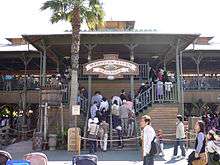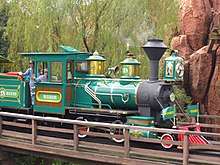Western River Railroad
Coordinates: 35°38′01″N 139°52′57″E / 35.633732°N 139.882427°E
| Western River Railroad | |
|---|---|
|
The attraction poster for the WRR | |
| Tokyo Disneyland | |
| Area | Adventureland |
| Status | Operating |
| Opening date | April 15, 1983 |
| General statistics | |
| Attraction type | Steam-powered locomotive |
| Designer | Walt Disney Imagineering |
| Length | 5,283 ft (1,610 m) |
| Vehicle type | Train |
| Vehicles | |
| No. of tracks | Single |
| Track gauge | 2 ft 6 in (762 mm) |
| Sponsor | Takara Tomy |
The Western River Railroad (reporting mark WRR) is a 2 ft 6 in (762 mm) narrow gauge rail transport attraction in Tokyo Disneyland, which opened on April 15, 1983. Its route is 5,283 feet (1,610 m) long and takes guests through Adventureland, Westernland, and Critter Country.[1] The railroad is one of two rail attractions at Tokyo Disney Resort, the other being the DisneySea Electric Railway at Tokyo DisneySea.
Overview
The Western River Railroad differs from other Disney railroad attractions in that it does not does not circle the whole park. Additionally, this railroad differs from other Disney railroads because its track gauge is 2 ft 6 in (762 mm) narrow gauge as compared with other Disney railroad track gauges of 3 ft (914 mm) narrow gauge.
At the time that the Western River Railroad was opened, Japanese rail regulations required that any railway line with more than one stop be subject to the same rules as any other conventional rail line, which included running on a timetable and collecting fares (the law was later abolished on April 1, 1987). As such, there is only one stop on the Western River Railroad in order to avoid having to charge fares and to allow the use of passenger cars that are not fully enclosed, which would not be allowed otherwise.[2]
The railroad was sponsored by Takara Tomy.[3]
Ride experience

Going clockwise around the loop, the train departs Adventureland Station, and passes through a Western-themed train station (though the train does not stop here).[4] After that, the train goes through a forest where passengers are able to see animatronic displays of wild animals and Native Americans.[4] Continuing down the line, the train crosses over a long trestle through the Critter Country section and the Big Thunder Mountain Railroad attraction in the Westernland section.[4] Finally, it enters through a deep tunnel containing the Primeval World Diorama (featuring animatronic dinosaurs) and exits back to the Adventureland Station.[4]
Rolling stock
Western River Railroad | |||||||||||||||||||||||||||||||||||||||||||||||||||||||||||||||||||||||||||||||||||||||||||||||||||||||||||||||||||||||||||||||||||||
|---|---|---|---|---|---|---|---|---|---|---|---|---|---|---|---|---|---|---|---|---|---|---|---|---|---|---|---|---|---|---|---|---|---|---|---|---|---|---|---|---|---|---|---|---|---|---|---|---|---|---|---|---|---|---|---|---|---|---|---|---|---|---|---|---|---|---|---|---|---|---|---|---|---|---|---|---|---|---|---|---|---|---|---|---|---|---|---|---|---|---|---|---|---|---|---|---|---|---|---|---|---|---|---|---|---|---|---|---|---|---|---|---|---|---|---|---|---|---|---|---|---|---|---|---|---|---|---|---|---|---|---|---|---|
| |||||||||||||||||||||||||||||||||||||||||||||||||||||||||||||||||||||||||||||||||||||||||||||||||||||||||||||||||||||||||||||||||||||
The Western River Railroad has four 2 ft 6 in (762 mm) narrow gauge 2-4-0 steam locomotives built by Kyosan Kogyo Co., which were named after famous rivers located primarily in the Western United States (hence the name of the railroad).[5] All four locomotives were designed to resemble the Denver & Rio Grande Montezuma locomotive, which was built by Baldwin Locomotive Works.[4]
The rail line also uses passenger cars based on the Narragansett-style excursion cars used on the Disneyland Railroad and Walt Disney World Railroad. Twelve cars were built, with three coaches assigned to each locomotive. Guests face forward in the passenger cars. Each coach has a small door in each row of seats that swings inward as a safety precaution.[2]
| Number | Name | Namesake | Image | Wheel arrangement | Date built | Builder | Serial number | Passenger cars | Date entered service | Notes |
|---|---|---|---|---|---|---|---|---|---|---|
| 53 | Colorado | Colorado River | .jpg) |
2-4-0 | N/A | Kyosan Kogyo Co. | 10096 | Three reddish brown passenger cars (100 series) | April 15, 1983 | The locomotive's number, 53, refers to the year 1953 when Walt Disney presented the plans for the original Disneyland. The livery is reddish brown. It has small diamond stack smoke stack. There is an elk on each side of the headlamp.[6] |
| 28 | Missouri | Missouri River |  |
2-4-0 | N/A | Kyosan Kogyo Co. | 10095 | Three green passenger cars (200 series) | April 15, 1983 | The locomotive's number, 28, refers to the year 1928, when the Disney animated short Steamboat Willie was released, the first cartoon with synchronized sound. The livery is green. It has a small diamond stack smoke stack. There are paintings of the Great Falls found by Lewis and Clark on the sides of the headlamp.[7] |
| 25 | Rio Grande | Rio Grande | 2-4-0 | N/A | Kyosan Kogyo Co. | 10094 | Three red passenger cars (300 series) | April 15, 1983 | The locomotive's number, 25, refers to the year 1925, when Walt Disney married his wife, Lillian Disney. The livery is red. It has a small diamond stack smoke stack, and a 2-4-0 wheel configuration. There is a grizzly bear on each side of the headlamp.[8] | |
| 20 | Mississippi | Mississippi River | 2-4-0 | N/A | Kyosan Kogyo Co. | 10100 | Three red/blue passenger cars (400 series) | April 15, 1983 | The locomotive's number, 20, refers to the year 1920 when Walt Disney, along with his friend Ub Iwerks, founded his first company, Iwerks-Disney Commercial Artists. Some of the design elements on this locomotive are slightly different than those on the other three locomotives. The livery is a red cab with a blue boiler jacket. It has a straight cap smoke stack. There are bison on the sides of the headlamp.[9] |
See also
References
- ↑ Broggie (2014), p. 347
- 1 2 Amendola (2015), p. 168.
- ↑ Broggie (2014), p. 346
- 1 2 3 4 5 Spence, Jack (May 14, 2010). "Disney Steam Trains – Part Four – Tokyo, Paris & Hong Kong". AllEars.Net. Archived from the original on May 11, 2017. Retrieved May 26, 2017.
- 1 2 Broggie (2014), pp. 395–396.
- ↑ Amendola (2015), p. 174.
- ↑ Amendola (2015), p. 171.
- ↑ Amendola (2015), p. 172.
- ↑ Amendola (2015), p. 169.
Bibliography
- Amendola, Dana (2015), All Aboard: The Wonderful World of Disney Trains (1st ed.), Disney Editions, ISBN 978-1-4231-1714-8
- Broggie, Michael (2014), Walt Disney's Railroad Story: The Small-Scale Fascination That Led to a Full-Scale Kingdom (4th ed.), The Donning Company Publishers, ISBN 978-1-57864-914-3
External links
| Wikimedia Commons has media related to Western River Railroad. |